If you’re here for the full review, read on. If you want to jump straight to the Age of Artisans expansion, click here.
We’re heading back to Garphill Games’ West Kingdom, taking a look at the first game in the trilogy. I started the series with Paladins, then Viscounts, and now I’m looping back around to the game that started it all – Architects of the West Kingdom. In terms of complexity, Architects is the lightest of the three games, but don’t let that fool you into thinking it isn’t as interesting, or as much fun as its sequels.
Set roughly 50 years before Paladins, Architects of the West Kingdom puts you in the role of a royal architect. Wanting to keep your noble status, you set to work gathering resources and money, endeavouring to build the most impressive buildings and landmarks in the Kingdom. It’s not all plain sailing though, as the other architects (your rival players) are out to do the same. This leaves you with a choice: rise above such petty competition and remain virtuous, or resort to thievery and hit the black market like it’s the Next Boxing Day sale.
Work experience
Architects of the West Kingdom is a worker-placement game in the classic style. It’s not a game like The Lost Ruins of Arnak, where there is worker-placement, but you only have two workers. In Architects you start with 20 workers, and an absolute ton of places you can put them. My first impression was “Wow, this reminds me of Stone Age”, and I can tell you that in my books, that’s high praise. Stone Age was my first worker-placement game, and it’s a game I still love dearly, all these years later.
Taking your turn in Architects is really simple. Take a player from your board and place them on any available work spot. For every worker of your colour now in that spot, your reward grows. That might mean your third worker in the Quarry nets you three pieces of stone, instead of one if it was your first worker placed there. In the Workshop, which acts as a market to hire new apprentices, the more workers you have, the further along the market rows you can choose from.
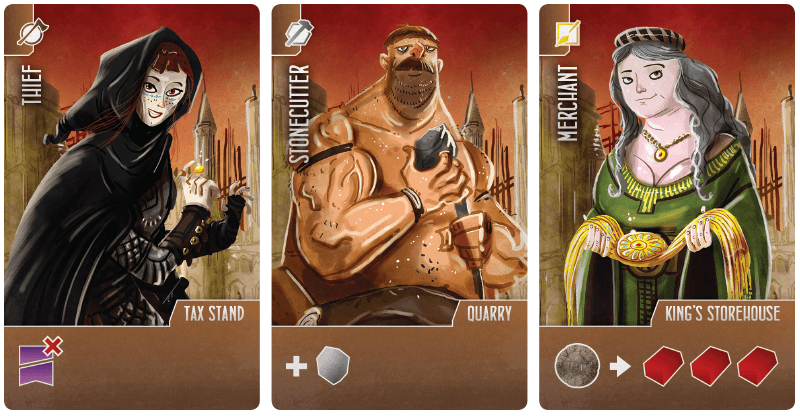
It’s such a simple concept, but one which works really well. Your first few turns feel really uneventful, just taking the odd resource here and there. Pretty soon though, things start to snowball, and you can start to tell how the other players intend to set out their stall. While in Stone Age there is really only two ways to score, and everybody competes for them, in Architects of the West Kingdom there are a few different ways to chase those elusive VPs. It means you can choose to take a different path to your rivals, or directly compete with them, which gives it the same feeling that Paladins and Viscounts carry through the rest of the series.
Banged-up
When you first start playing, it feels great to have all these workers available right from the start. It doesn’t take long to realise, however, that unlike in other worker-placement games, you don’t pick your workers back up. Once you place them on the board, they stay there. I remember my first learning playthrough, and thinking to myself “Okay, so you have 20 turns, one per worker”, which didn’t feel like enough. It was about then that I started playing with the Town Centre placement spot.
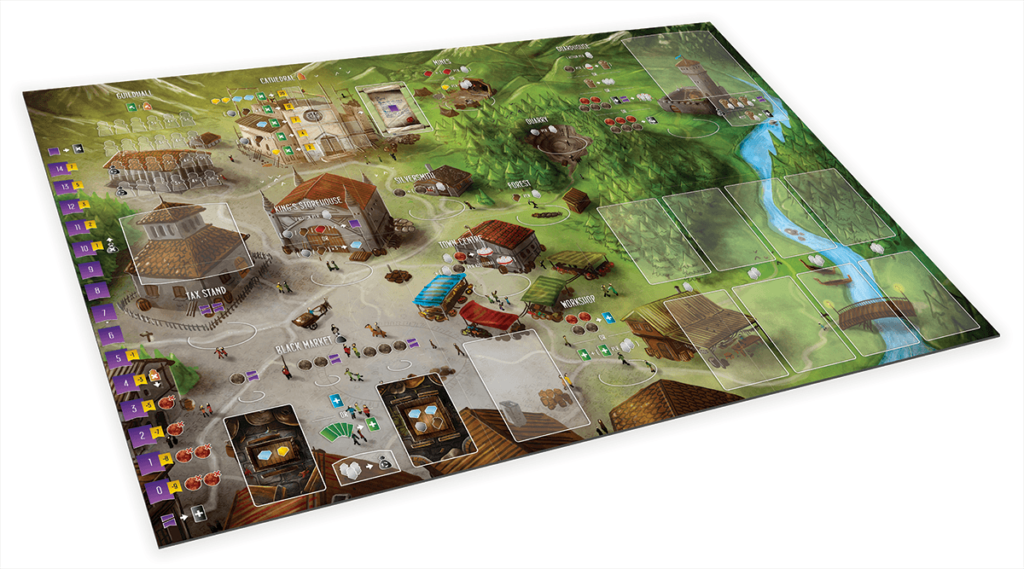
The Town Centre allows you to choose a space on the board, and to capture all of one player’s workers on that spot, moving them to your player board. This is the rivalry between the architects in action. Thematically you believe someone’s up to no good, or getting too greedy, so you make the equivalent of a citizen’s arrest. After all, you’re nobles, you wouldn’t lie about something like that, right? On a later turn you can drop them off at the prison for one piece of silver each. Reward for performing your civic duty, indeed!
You can visit the Guardhouse on a later turn to free any prisoners of your colour, and release them back to your board to use again later, and it’s a brilliant mechanism. So few Euro games offer this level of direct player interaction and scuppering of plans, it’s a breath of fresh air. What makes it especially clever is the way it allows you to change tactics later in the game. Workers freed from one place can go on to work somewhere else later, and there’s direct impetus to capture other players’ workers, as you can make a lot of coin by doing it.
Going solo
Garphill Games know how to make an automa opponent, and Architects of the West Kingdom is no exception. The solo mode is simple to understand and quick to run. There’s no faffing about, and the two different opponents – Constantine and Helena – give you two different difficulty levels to play against. The bot feels fair and balanced, and they’ll push you to play your best game.
The other really nice thing you can do with the bot is introduce it into a two-player game. Architects is fun with two, but at its best with three and four players, so being able to play a three-player game when there’s only two of you around a table is a really nice touch.
Final thoughts
I really like games on the heavier end of the complexity scale, and because I’d played Paladins and Viscounts first, I was worried that Architects might feel a bit too light for me to really enjoy. I needn’t have worried. Architects is lighter than the other two games, but it’s still a solid medium-weight game. The trademark iconography that carries through to all of the games in the series is easy to interpret, and immediately familiar to anyone who’s played any of the other games. The Mico’s artwork can be polarising, but if you like his illustration style, you’ll love this too.
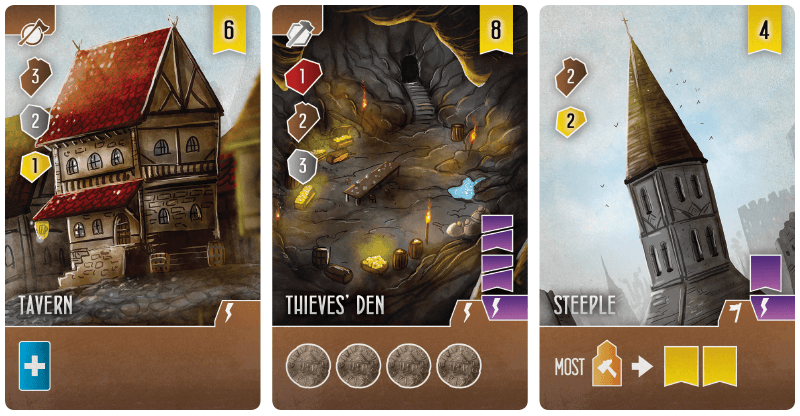
I felt real nostalgia and happiness when the game evoked memories of playing Stone Age, and I’m a really big fan of simple actions in worker-placement games. Put a meeple here, get the thing that’s printed on the board. No fuss, no obfuscation, just quick, easy turns. It’s for this reason that I think Architects of the West Kingdom will now be my go-to worker-placement introduction game. The player interaction that the capturing and releasing of other players’ workers brings to the game means it’s a fantastic game to try to tempt Euro-phobes with too. The complaint, which usually rings true with a lot of Euro games, is that they’re mostly multiplayer solitaire. No-one could accuse Architects of that.
If you enjoy pure worker-placement games, and you don’t already have Architects of the West Kingdom, you should get it, it’s as simple as that. It’s cheap these days, plays from one to five players, and is quick to pick up. Satisfyingly thinky without making it complicated, and it feels fun to come back to time and time again. It’s a cracking game, and it’s found a permanent home in my collection.
Review copy kindly provided by Garphill Games. Thoughts and opinions are my own

Architects of the West Kingdom (2018)
Designers: Shem Phillips, S J Macdonald
Publisher: Garphill Games, Renegade Game Studios
Art: Mihajlo Dimitrievski
Players: 1-5
Playing time: 60-90 mins
Age of Artisans expansion
Age of Artisans is the first expansion for Architects of the West Kingdom. It throws in a few nice changes, but does it without making the game overly complicated, or drastically altering the way the game is played. There’s a new, socketed Guildhall board to place on top of the main board, along with a new card to cover a spot in the Black Market, with some new iconography. The expansion explains that we now have master craftsmen returning to the kingdom, and they can add adornments to buildings, or create tools to improve your apprentices’ abilities.
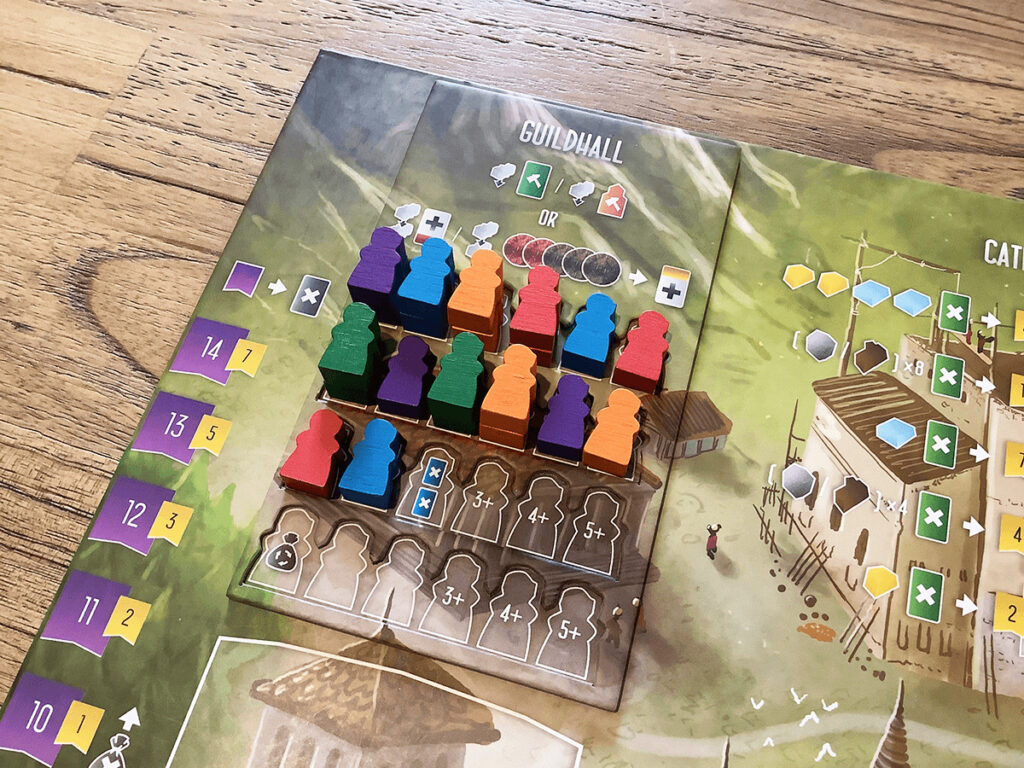
What that all means to you and I, is a new deck of dual-use cards, which can be bought and added to your buildings and apprentices to improve them. It’s a relatively simple change to the base game, but it adds some really interesting new choices. You can use the new cards to really min-max your strategy (i.e. go heavily for buildings and adorn them), or to off-set weaker areas. Along with the new cards, each player gets an additional Artisan meeple. This bigger, chunkier worker counts as two workers when you place them (powerful!), and it also reduces the loss of virtue you’d normally suffer for some of the less savoury actions on the board.
Table for six, sir?
The other really nice addition that Age of Artisans brings, is a new player colour – orange – and along with it, the ability to play up to six-player games. I haven’t had a chance to get six players around a table yet to try it (thanks Covid-19), but having played with four, I can see how six would be chaotic, and a lot of fun. There’s a couple of new player boards in the box too, which offer some new initial setups for players, and breathe a bit of life back into the game if you’ve played it to death already.
The excellent solo game from the base game also makes the transition to Age of Artisans really easily too. The AI player takes adornments with a really simple decision process, and games against it still feel really balanced and fair.
Final thoughts
Age of Artisans is a really nice expansion. It adds plenty of new depth without changing the base game too much. It’s very easy to learn the new actions and features, and if you don’t feel confident using them, you can still compete just using the base game actions. At a shade under £30, it’s quite an expensive expansion when you consider what’s in the box, but when you consider the fact that the Garphill games are usually very reasonable, I don’t think it’s too bad.
If you’ve not played Architects of the West Kingdom yet, play it a few times before getting this expansion, just to make sure it’s a good fit with your group. If you’ve played it and loved it, then Age of Artisans is a great choice. It’s adds plenty to increase the lifespan of the game, and the addition of a sixth player is great. There are so few euro games at all, let alone worker-placement games, that play up to six, so it’s a fantastic option if you have a bigger group.
Expansion kindly provided by Garphill Games. Thoughts and opinions are my own.
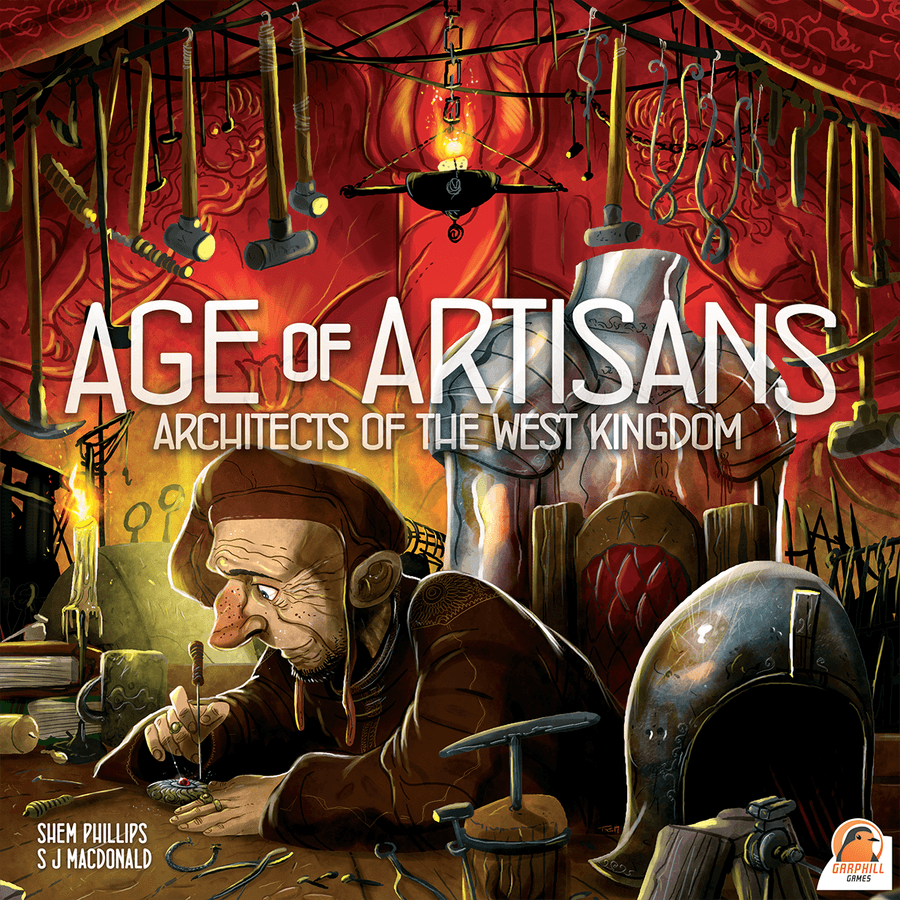
Age of Artisans (2020)
Designer: Shem Phillips, S J Macdonald
Publisher: Garphill Games, Renegade Game Studios
Art: Mihajlo Dimitrievski
Players: 1-6
Playing time: 60-90 mins
